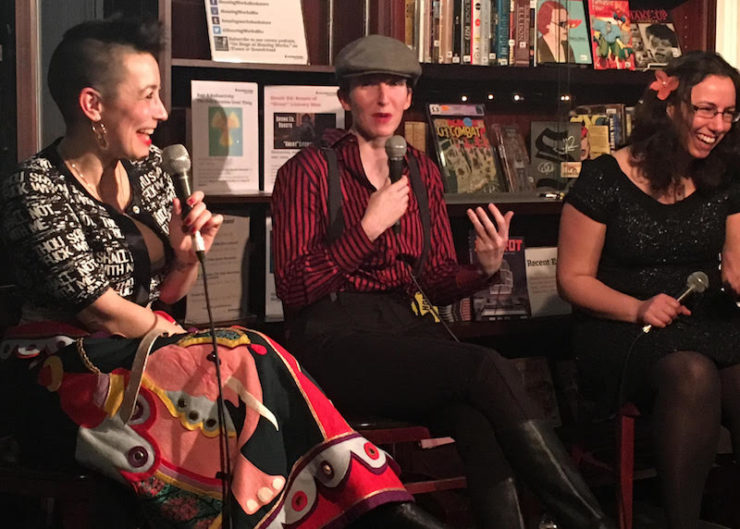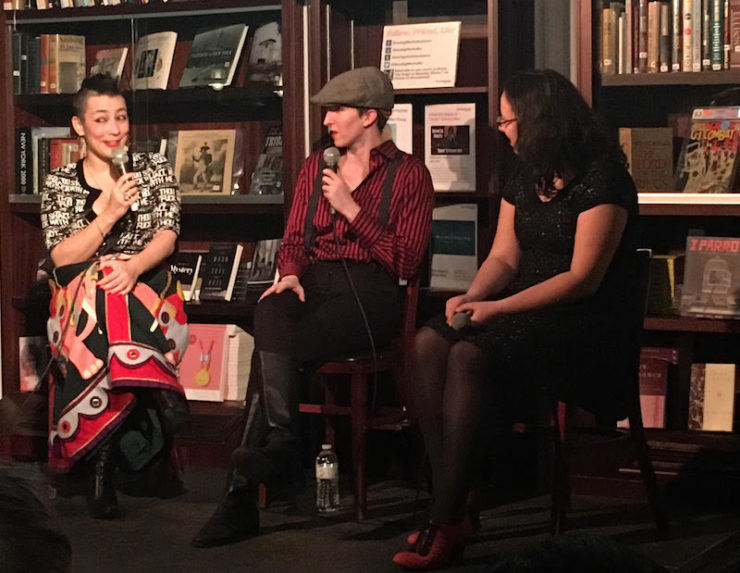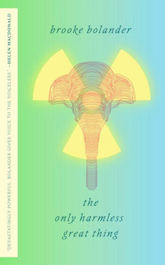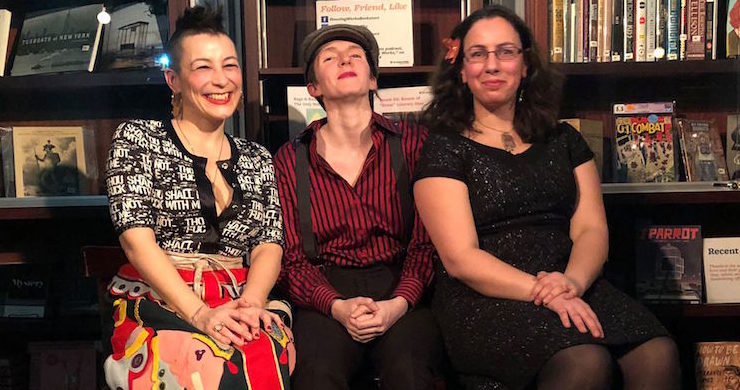Brooke Bolander, Maria Dahvana Headley, and Amal El-Mohtar came together at Housing Works Bookstore Cafe to discuss Bolander’s new book, The Only Harmless Great Thing, but what began as a book launch became a long, complex discussion of the power of storytelling, the horrors of capitalism, and the power of women who come together to record truth.
Brooke Bolander’s alternate history novella, The Only Harmless Great Thing, connects the story of Topsy the Elephant with that of The Radium Girls, two tragedies from the early 20th Century. Topsy was electrocuted publicly after trying to defend herself from a series of abusive trainers; the Radium Girls were factory workers who were poisoned while painting radioluminescent watch dials, because their bosses insisted they wet their brushes in their mouths to save time. The book delves into these two atrocities, while also telling a story of an ancient lineage of elephants, and skipping into the near future to look at the aftermath of America’s obsession with nuclear power.
El-Mohtar began by asking if her two co-panelists grew up with animal stories.
Bolander: Growing up I read anything with animals in it. My earliest favorites were probably dinosaur stories. I grew up in the woods, running wild, feral with animals anyway… so read what you know I guess? [laughter]
Headley: Bo and I had basically the same childhood. I grew up in rural Idaho, and the stories… they were always hunter stories. Told from the perspective of the hunter… like Ernest Thompson Seton, and his stories about tracking Lobo the wolf—[This is met by enthusiastic nodding from Bo]—the wolves were tricky and cool. I think we were both just bonded to the animals in those stories.
Bolander: Yeah, all my stories are angry pissed-off animals and angry pissed-off women. If the animals have to die, they’re gonna goddamn take people with them!
The discussion turned to the way male-centric science reverberated through science and the arts, with the now-debunked idea of alpha males within wolf society (“Projecting a bit, maybe?” Bolander asked, to audience laughter) as well as the way male-authored fables are passed down through generations. El-Mohtar pointed out that “the male-written stories, Animal Farm, Watership Down – those are the ones that become classics and make it onto syllabi, and are passed down to future generations”.
She continued, “and then you get to fairy tales, and there are so many beastly bridegrooms, and animal transformations.” Bolander highlighted that in these cases, it’s always the woman changing the man, “reforming him.”

El-Mohtar explained that where most animal fables take an aspect of human society and blow it up in order to critique it, Bolander’s novella provides an animal-centric history in the form of the stories passed down through the elephant society from the “Furmother,” a venerable female mammoth. Also, rather than being a vague allegory, Bolander book is “looking at real, historical, horrific abuse”—the history of Topsy and of the Radium Girls.
Headley mentioned the act of the elephants eating stories, and Bolander connected it to the history of the Radium Girls:
It’s a horrific bit of capitalist history. The scientists making the shit were wearing real protective gear, and they were hiring girls to paint radium on glow-in-the-dark dials, and they would wet the brushes with their mouths. Which, then when the women started getting jaw cancer, and tried to sue the company, the the company responded by claiming they had syphilis. They tried to create a story that the women were “whores.”
Topsy came into the story because of the similar theme of capitalism run amok. Bolander explained, “Her trainer was a drunk, and he burned her with a cigar. So she did what elephants so, she picked him up and smashed him!” Applause broke out, and Bolander continued, “She was sold to Luna Park, where she was abused again, by a different trainer. They then decided that they would electrocute her, and, to promote the park, they’d film it. It wasn’t actually Thomas Edison who did it—he electrocuted other animals, but not Topsy—but it was the Edison film crew. You can find it online if you want to have a really bad time.”
Headley mentioned that through all of the threads of the book, there’s a theme of “killing the mother—which of course is the whole history of humanity—then trying to kill the stories, to silence the women telling them.”
Finally El-Mohtar asked about the book’s near-future element, an ongoing project to warn future generations about nuclear waste, which led to the best story of the night.
Bolander: In the ’80s—so I’m assuming there was cocaine involved—a group of scientists came up with this idea: why not genetically engineer cats that change color when they’re near radioactivity? Because they figured that cats will always be popular. People will always like them. So they’d start telling stories about these cats, and a folklore would grow up around them.
El-Mohtar: WHAT.
Bolander: Yeah, it’s called ‘The Ray-Cat Solution.’ But then they were like…why don’t we try…a sign.

The three dug into a theme that features prominently in all of their writing, what Headley termed “what-was-done-to-us.”
Bolander said that she wanted to explore the “consequences” of what was done to the Radium Girls, and to Topsy, and ask, “Who is telling this story? And how are they twisting it?”
El-Mohtar related Bolander’s novella to Muriel Ruykeyser’s poem “The Book of the Dead” about the Gauley Bridge mining disaster:
The owners of the mine found a vein of pure silica, and decided it would be cheaper to bribe doctors to falsify the miners’ death certificates than it would be to provide protective gear. Let them die. Write it off. And this didn’t come to light until a woman, a social worker, went into the community alone and went house-to-house interviewing the families of survivors. She went to Congress with her findings, and was treated horribly, but then she, the poet Ruykeyser, and a photographer, who was also female, brought this truth to light. And I thought of that the entire time I was reading your book—this communication between women, and the precarious nature of knowledge.
The conversation continued:
Bolander: “It was also a woman, actually, who told the safety inspector that his report [on the dangers of radium poisoning] had been falsified.”
Headley: “And it was part of the job description that you had to lick the brush, right? Reading the book, I just got this sense of…longing for the dial, a longing for time to stop. And then for these women to get into the record. So the deaths would be on the record of history.
El-Mohtar: “It’s a the longing for progress without any concern for who will be hurt by it.”
Headley: “I was thinking too, of testing beauty products on animals—you’re hurting animals to test products so women can glow in the dark, and stop time!”
On the subject of who gets to record history, El-Mohtar also asked Headley to talk about her story, “The Orange Tree.” (anthologized in The Weight of Words, edited by Dave McKean and William Schafer)
Headley: A golem is commissioned by a poet—a female, wooden, golem—to do his housework. He gets arrested, and is forced to dismantle the golem—because of course he’s using it as a sex robot. It’s written from the golem’s point of view. I wanted to ask, what is it to be conscious for such a short time, and then be unmade? And throughout he writes poems and puts them in her mouth. And I just loved the idea of taking history, and Frankenmashing it together, to give voices back to people who have been silenced.
Buy the Book


The Only Harmless Great Thing
The three authors then gave some excellent tag-team-style writing advice:
Headley: “The danger of stories is that they become monuments and overshadow the truth they were supposed to convey, so I try to tell aggressive, radical stories…as prettily as possible.”
Bolander: “Sneak the medicine in!”
Headley: “A spoonful of poetry makes the entire patriarchy go down.”
El-Mohtar: “And try to always be uncomfortable!”
Headley: “If you’re always be asking yourself, ‘is this allowed? …OK, is this allowed?’ it’s a good start.”
El-Mohtar: “And ask yourself: ‘What good is this doing, and what harm is this doing?’ as you write.”
They ended the panel by honoring Ursula K. Le Guin, with El-Mohtar calling her “a woman who cannot be erased from history.” And adding, “We’re three women who are writing about women who are trying to preserve truth, and I’d like to think she’d approve.”
The Only Harmless Great Thing is out now from Tor.com Publishing. You can read an excerpt here.










